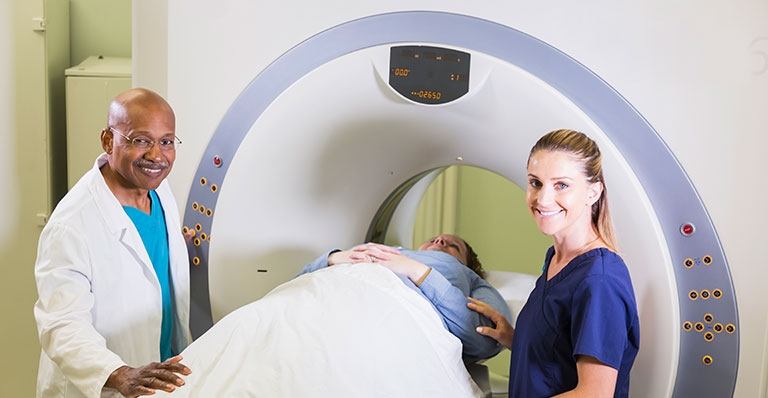This is a test that uses hundreds of x-rays to make an image of the body.
The test is done by having a person lay on a bed that moves through a donut-shaped machine. You must lay still while the scan is done.

Advantages
- Provides an excellent picture of the kidney anatomy including the blood supply, functioning tissue and the drainage tubing and is considered the standard test to evaluate kidney cysts and tumors.
- Most tests take only 15-30 minutes to do.
- Best at seeing kidney stones, even the tiniest ones.
Disadvantages
- This test exposes people to radiation, which may increase a person’s risk of cancer in their lifetime by about 0.05%. This is a very small risk but may accumulate if a person requires dozens of CT scans over their lifetime. You also have to weigh these risks against the risk of missing an important medical problem, such as a kidney cancer or other diseases. We always make our patients aware of these risks and only order this test if it is medically necessary.
- In order to see the kidneys and evaluate cysts and tumors best, the test must be done with IV dye. IV dye allows us to see parts of the organs that may be very difficult to see without the contrast. It is like seeing a person in the dark (without IV dye-contrast) versus seeing the same person in the light (with IV dye-contrast). The good news for kidney stone patients is that kidney stones are best seen without IV dye. The concern comes in those people who are allergic iodine or shellfish who may also be allergic to the IV dye. In people with a contrast allergy, we may sometimes avoid the IV dye, but may also give antihistamines and steroids to lower the risk of an allergic reaction.
- Besides allergic reactions, the IV dye also poses a risk to some patients with underlying kidney function problems as it may temporarily cause worsening kidney function. This is the reason we get blood tests to check kidney function within 30 days prior to the CT scan. In cases, where the function is poor, the scan may be done without IV dye. In cases where the function is borderline poor, we may administer the IV dye along with IV hydration prior to and after the CT scan is done.
- The test requires a person to lay inside a “donut-like” machine which may make some people claustrophobic. Sometimes, the test is quick enough that most patients do not become anxious. However, some patients feel better with some anti-anxiety medicine given prior to the test.

